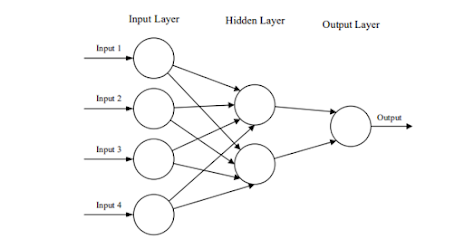· INTRODUCTION:
Tool faults have attracted research interest. Tool wear is affected by several factors which influence monitoring cutting tools to track defects and avoid them.
Several approaches are considered like ‘Online/Indirect’, where acquisition of parameters like Cutting Speed, Tool Temperature, Feed Rate, Forces, using suitable Transducers & ‘Off-line/ Direct’, where vision-based techniques like Laser Scatter Pattern, Scanning Electron Microscopy are seen.
The online approach is suitable for knowledge-based ML learning schemes. Several investigations related to the study of Vibration Signals to review Tool Health were given.
· METHODOLOGY:
The diagram shows the methodology used; the tool conditions were categorized using 6 algorithms which are:
1. Decision tree (J48) classifier- A decision tree serves as an efficient tool in the domain of judgmental investigation. It is a special algorithm that performs a dual role i.e. while constructing the classification model it assists in the selection of attributes. It exhibits a hierarchical pattern of decisions similar to tree
2. Logistic model (LM) tree classifier- It is a dual-scheme classifier incorporating modelling logistic regression while training decision rule sets. The classic decision tree having constants located at leaves generates a piecewise-constant model, but the LMT constructs a standard structure of the tree using logistic regression (LR) at each leaf, similar to the model tree.
3. Random Forest classifier- A (binary) decision tree is a series of (binary) questions that can be programmatically schematized as nested if-then-else statements and represented as an acyclic graph directed outwards from a root node and having the following properties:
a) Each node can have zero (a leaf) or two descendants (a test node)
b) Each node has one parent, except for a single node called the root which has no parent.
4. Best First (BF) tree classifier- Best First search algorithm expands the most significant node using heuristic estimation function ‘f(n)’ based on factors like an illustration of ‘n’, the expected outcome, the information gained during the search, and any other additional information about datasets.
5. Functional tree classifier- The functional tree studies the influence of features’ fusion at various parts of the decision tree i.e., all types of node points, leaves, etc.
6. Simple CART classifier- Classification & Regression Tree is a decision tree-based supervised learning approach for building models in ML. Also, a comparative study was made for finding Best Classifier & Validation was done using k-fold test mode. Tool Configurations were considered, and 6 operations were considered, where we plotted the Number of Samples against the Acceleration.
· EXPERIMENTATION:
1. The experimental set-up consisted of a Vertical Machining Centre (CNC-VMC), an accelerometer, a data acquisition system.
To be more specific,
• Machine tool: CNC-VMC VTEC-CCS00605 (X = 4200 mm, Y = 2600 mm, Z = 920 mm)
• Work-piece material: Mild Steel
• Work-piece shape: Rectangular hollow cube of form ‘C’
• Workpiece size: Length = 650, Breadth: 250, Height = 100 (all dimensions are in mm)
• Milling tool: Milling cutter of diameter 63 mm
• Number of inserts: 4 (carbide coated)
• Operation performed: Face milling
• Machining parameters:
§ Spindle speed = 900 revolutions per minute
§ Feed = 2000 mm/min
§ Cut Depth = 0.25 mm
§ Data acquisition (DAQ): Vibration analyser (Make DEWE 43 A)
§ Sensor: Piezoelectric accelerometer (Make PCB-J356A43, acceleration: 500 g, sensitivity: 10 mV/g)
2. Vibration response is generally collected from the location near the dynamic component of machines. Hence, the accelerometer was fixed on the spindle frame, held in a vertical direction as the drive shaft revolves vertically.
3. The sampler frequency was chosen as 20 kilohertz, considering the Nyquist theorem.
4. Sampling length of 2048 was chosen since 211=2048 data points of Acceleration Amplitude Readings for 240 samples i.e., 40 samples in Tool Configuration, and a training data sheet was created.
5. Thus, Feature Extraction and Feature Selection were implemented.
· RESULTS & CONCLUSION:
1) 13 Statistical attributes were extracted namely, (1) Kurtosis, (2) Standard Error, (3) Maximum value, (4) Skewness, (5) Minimum value, (6) Range, (7) Count, (8) Summation, (9) Variance, (10) Standard Deviation, (11) Mode, (12) Median (13) Mean.
2) Now the classification accuracies were as follows:
a) J48 Decision Tree- 96.2%
b) Random Forest (RF)- 96.2%
c) e Logistic Model Trees (LMT)- 96.2%
d) Best First Tree (BFT)- 97%
e) Functional Trees (FT)- 95.4%
f) Simple CART- 96.2%
3) The Best First Tree algorithm yields the highest accuracy as 97%, and the time required to build the model is lowest i.e., 0.2 s, hence, endorsing the satisfactory training of the model. The J48, LMT, RF, SC yields the same accuracy as 96.2% and, the FT offers the lowest accuracy as 95.4% amongst all tree family classifiers. The time consumed in constructing the model for LMT is 5.3 s which is the highest in all.
References:
https://scholar.google.co.in/citations?user=u4zim9MAAAAJ&hl=en
https://www.sciencedirect.com/science/article/abs/pii/S0263224120311659
https://www.researchgate.net/publication/345054760_A_machine_learning_approach_for_vibration-based_multipoint_tool_insert_health_prediction_on_Vertical_Machining_Centre_VMC
https://scholar.google.co.in/citations?hl=en&user=u4zim9MAAAAJ
https://www.scopus.com/authid/detail.uri?authorId=57204179235
Note: This blog is meant for educational purposes only. We do not own any Copyrights related to images and information, all the rights go to their respective owners. The sole purpose of this blog is to Educate, Inspire, Empower, and create awareness in the viewers. The usage is non-commercial (Not for Profit) and we do not make any money from it.
FOLLOW US ON:-
INSTAGRAM:https://bit.ly/coep_blogs_insta
LINKEDIN:https://bit.ly/coep_blogs_linkedIn
YOUTUBE:https://bit.ly/Coep_blogs_YouTube








